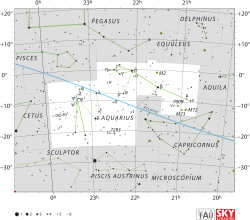Tau2 Aquarii
| Observation data Epoch J2000 Equinox J2000 | |
|---|---|
| Constellation | Aquarius |
| Right ascension | 22h 49m 35.501s[1] |
| Declination | –13° 35′ 33.46″[1] |
| Apparent magnitude (V) | +4.042[2] (3.98 to 4.04)[3] |
| Characteristics | |
| Spectral type | K5 III[4] or M0 III[5] |
| U−B color index | +1.948[2] |
| B−V color index | +1.566[2] |
| Variable type | Suspected[3] |
| Astrometry | |
| Radial velocity (Rv) | +1.1±0.8[6] km/s |
| Proper motion (μ) | RA: −13.386 mas/yr[1] Dec.: −38.609 mas/yr[1] |
| Parallax (π) | 10.0171±0.1734 mas[1] |
| Distance | 326 ± 6 ly (100 ± 2 pc) |
| Absolute magnitude (MV) | −1.28[7] |
| Details | |
| Radius | 51.5+4.6 −5.5[8] R☉ |
| Luminosity | 614±27[8] L☉ |
| Surface gravity (log g) | 1.63[9] cgs |
| Temperature | 4,007+232 −166[8] K |
| Other designations | |
| τ2 Aquarii, τ2 Aqr, 71 Aquarii, NSV 14329, BD–14° 6354, FK5 861, GC 31836, HD 216032, HIP 112716, HR 8679, SAO 165321, PPM 240808, WDS J22496-1336A[10] | |
| Database references | |
| SIMBAD | data |
Tau2 Aquarii is a solitary[11] star in the equatorial constellation of Aquarius. Its name is a Bayer designation that is Latinized from τ2 Aquarii, and abbreviated Tau2 Aqr or τ2 Aqr. This star is visible to the naked eye with an apparent visual magnitude of +4.0.[2] Because the star lies near the ecliptic it is subject to occultations by the Moon.[12] The star is located at a distance of approximately 326 light-years (100 pc) from the Sun based on parallax.[1] It is drifting further away with a radial velocity of about +1.1 km/s.[6]
This is an orange-hued[13] red giant star with a stellar classification of K5 III.[4] After exhausting the supply of hydrogen at its core, the aging star cooled and expanded off the main sequence. It now has 52 times the radius of the Sun and is radiating 614 times the Sun's luminosity from its enlarged photosphere at an effective temperature of 4,007 K.[8] This is a suspected variable star with a brightness that has been measured ranging from visual magnitude 3.98 down to 4.04.[3]
A magnitude 9.94 visual companion to this star was reported by W. Herschel in 1782, and it has the modern discovery code 'H 6 97'. As of 2010, it was located at a wide angular separation of 132.40″ from the brighter star along a position angle of 297°.[14]
References
[edit]- ^ a b c d e Vallenari, A.; et al. (Gaia collaboration) (2023). "Gaia Data Release 3. Summary of the content and survey properties". Astronomy and Astrophysics. 674: A1. arXiv:2208.00211. Bibcode:2023A&A...674A...1G. doi:10.1051/0004-6361/202243940. S2CID 244398875. Gaia DR3 record for this source at VizieR.
- ^ a b c d Gutierrez-Moreno, Adelina; et al. (1966), "A System of photometric standards", Publ. Dept. Astron. Univ. Chile, 1, Publicaciones Universidad de Chile, Department de Astronomy: 1–17, Bibcode:1966PDAUC...1....1G.
- ^ a b c Samus', N. N.; et al. (2017), "General catalogue of variable stars", Astronomy Reports, 5.1, 61 (1): 80, Bibcode:2017ARep...61...80S, doi:10.1134/S1063772917010085, S2CID 125853869
- ^ a b Houk, Nancy (1978), Michigan catalogue of two-dimensional spectral types for the HD stars, vol. 4, Ann Arbor: Dept. of Astronomy, University of Michigan, Bibcode:1988mcts.book.....H.
- ^ Keenan, Philip C.; McNeil, Raymond C. (1989), "The Perkins catalog of revised MK types for the cooler stars", Astrophysical Journal Supplement Series, 71: 245, Bibcode:1989ApJS...71..245K, doi:10.1086/191373.
- ^ a b Gontcharov, G. A. (2006), "Pulkovo compilation of radial velocities for 35495 stars in a common system", Astronomy Letters, 32 (11): 759–771, arXiv:1606.08053, Bibcode:2006AstL...32..759G, doi:10.1134/S1063773706110065, S2CID 119231169.
- ^ Pace, G.; et al. (2003), "The Wilson-Bappu effect: A tool to determine stellar distances", Astronomy and Astrophysics, 401 (3): 997–1008, arXiv:astro-ph/0301637, Bibcode:2003A&A...401..997P, doi:10.1051/0004-6361:20030163, S2CID 17029463.
- ^ a b c d Brown, A. G. A.; et al. (Gaia collaboration) (August 2018). "Gaia Data Release 2: Summary of the contents and survey properties". Astronomy & Astrophysics. 616. A1. arXiv:1804.09365. Bibcode:2018A&A...616A...1G. doi:10.1051/0004-6361/201833051. Gaia DR2 record for this source at VizieR.
- ^ Bordé, P.; et al. (October 2002), "A catalogue of calibrator stars for long baseline stellar interferometry", Astronomy and Astrophysics, 393 (1): 183–193, Bibcode:2002A&A...393..183B, doi:10.1051/0004-6361:20021020.
- ^ "tau Aqr". SIMBAD. Centre de données astronomiques de Strasbourg. Retrieved 2021-06-08.
{{cite web}}: CS1 maint: postscript (link) - ^ Eggleton, P. P.; Tokovinin, A. A. (September 2008), "A catalogue of multiplicity among bright stellar systems", Monthly Notices of the Royal Astronomical Society, 389 (2): 869–879, arXiv:0806.2878, Bibcode:2008MNRAS.389..869E, doi:10.1111/j.1365-2966.2008.13596.x, S2CID 14878976.
- ^ White, Nathaniel M.; Feierman, Barry H. (September 1987), "A Catalog of Stellar Angular Diameters Measured by Lunar Occultation", Astronomical Journal, 94: 751, Bibcode:1987AJ.....94..751W, doi:10.1086/114513.
- ^ "The Colour of Stars", Australia Telescope, Outreach and Education, Commonwealth Scientific and Industrial Research Organisation, December 21, 2004, archived from the original on 2013-12-03, retrieved 2012-01-16.
- ^ Mason, B. D.; et al. (2014), "The Washington Visual Double Star Catalog", The Astronomical Journal, 122 (6): 3466–3471, Bibcode:2001AJ....122.3466M, doi:10.1086/323920.


 French
French Deutsch
Deutsch